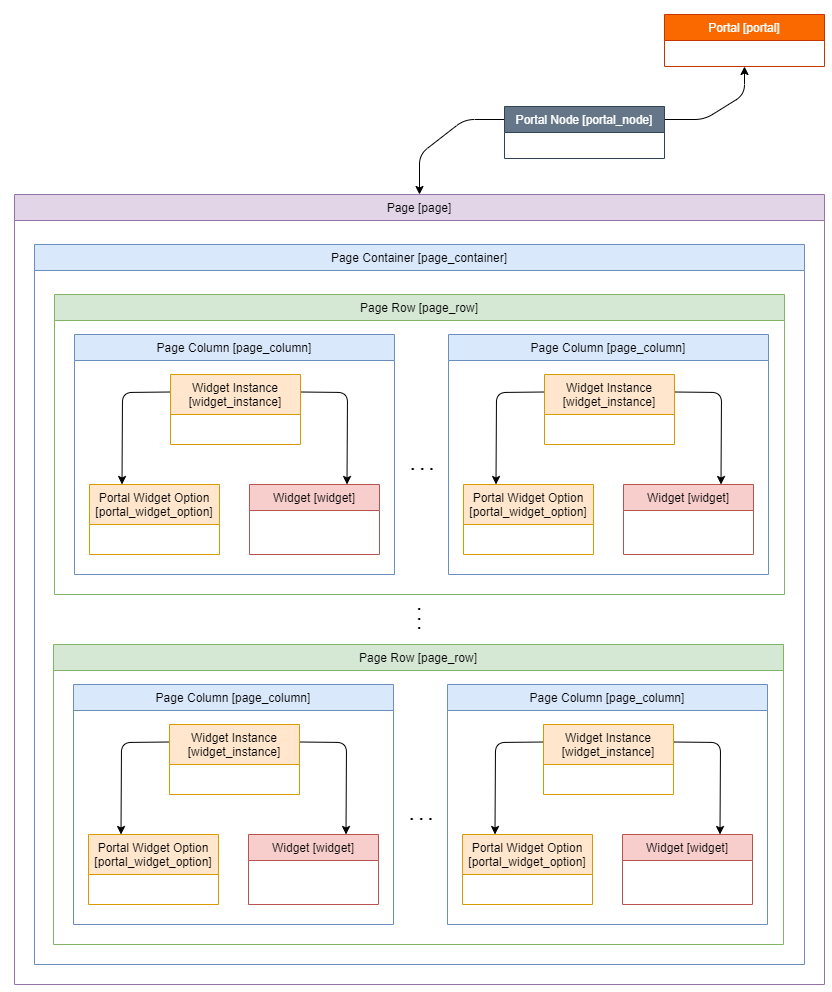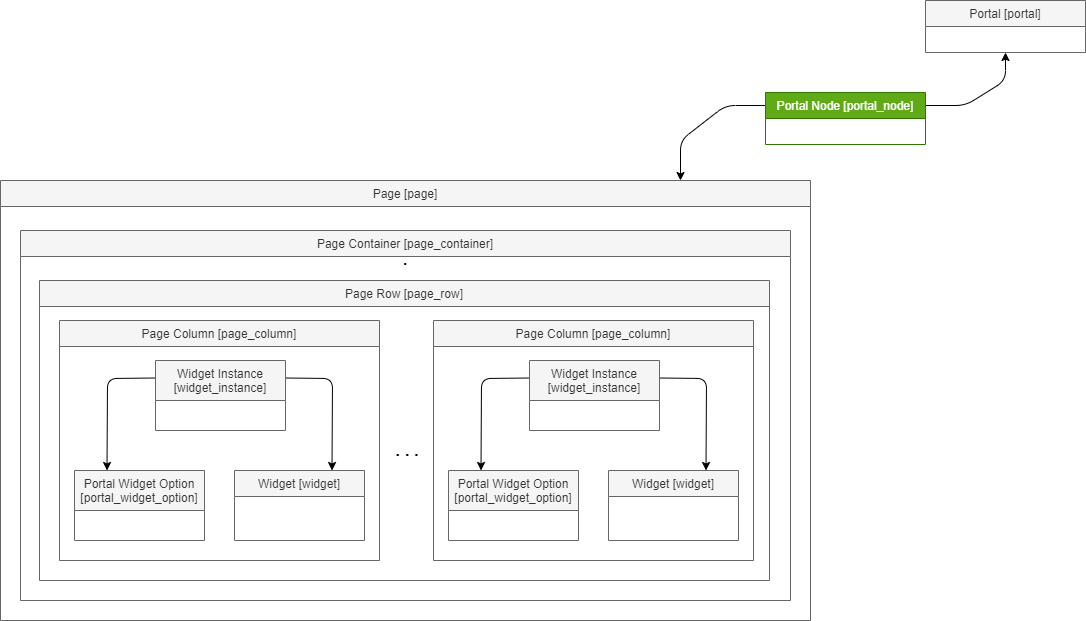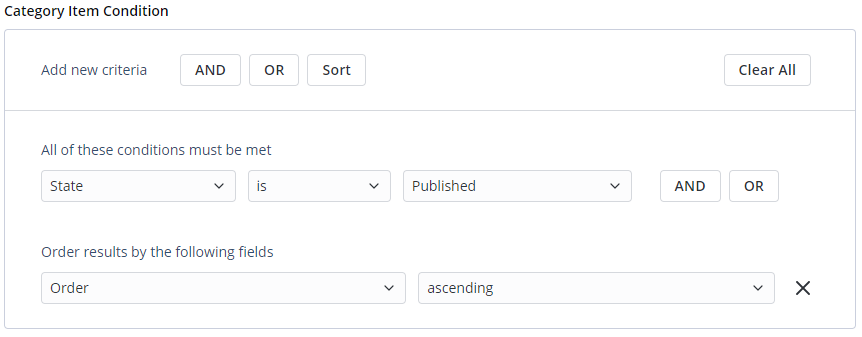Versions Compared
Key
- This line was added.
- This line was removed.
- Formatting was changed.
When you create a page, you can make it available on the portal. To do thisso, you need to create the a portal node , that will bind your page with the portal record.
The following diagram illustrates a typical portal structure:
 Image Removed
Image Removed Image Added
Image Added
Integrate a page into a portal
To perform thisintegrate a page into a portal, you need to complete the step-by-step instructionssteps below:
- Create a Portal portal record.
- Create a Portal portal node.
- Create a Page page.
| Note |
|---|
You should Before configuring, consider the portal structure first before configuring. So it It should have at least one portal node and at least one page to work properly. Otherwise, it will not display correctly. |
Anchor Portal records Portal records
Create a portal
records| Portal records | |
| Portal records |
record
Create a portal record, so you will be able to bind lower-level objects to it going through further steps. Image Removeda page, its elements, and a portal node to it.
Image Removeda page, its elements, and a portal node to it.
To create a single portal, please complete the steps below:
- Navigate to Portal Structure → Portals.
- Click New and fill in the fields.
- Click Save or Save and Exitexit to apply the changes.
| Tip |
|---|
When filling in the Path Namename field, keep in mind , that this is the URL suffix of your future portal, so fill in this field carefully. |
Portal form fields
| Field | Mandatory | Description | ||||||
|---|---|---|---|---|---|---|---|---|
| Title | - | Specify an internal portal title. | ||||||
| Path name | - | Specify a suffix to use in a portal URL. For example, if you type portal, the instance URL for this portal will be <your_instance_url>/portal
| ||||||
| Logo | - | Specify a portal logo appearing in the page header. | ||||||
| Favicon | - | Specify a portal favicon appearing in the browser tab. | ||||||
| - | Define the portal-specific SCSS classes to customize the portal. | ||||||
| - | Define the portal-specific SCSS styles to customize the portal. | ||||||
| Active | - | Select the checkbox to make the portal active or inactive. | ||||||
| Login page | - | Specify a login page for the portal. | ||||||
| Home page | - | Specify a home page for the portal. | ||||||
| 404 page | - | Specify a 404 error page for the portal. | ||||||
| Footer container | - | Specify a portal footer. | ||||||
| Header container | - | Specify a portal header. | ||||||
| Header navigation menu | - | Specify a reference to the portal header menu that is implemented with the corresponding tree. |
| Anchor | ||||
|---|---|---|---|---|
|
node
Within the portal node, there are two various essence types are used to configure the portal structure:
- Portal nodes, also known as portal maps, are massive structural components defining layouts of portals, categories, and pages through the Portal Page field.
- Categories and items are pages that bind child objects based on the same features. Categories are any structures based on parent-child relationships, e.g., Knowledge Base with categorized Articles in it. Portal Nodes help implement ready-to-use structures into the portal structure.
 Image Removed
Image RemovedTo create a portal node, complete the steps below:
- Navigate to Portal Structure → Portal Nodes.
- Click New and fill in the fields.
- Click Save or Save and Exitexit to apply the changes.
Portal Node form fields
Field | Mandatory | Description | ||
|---|---|---|---|---|
| Portal | - | Specify a portal to define a structure with the portal node. | ||
| Parent node | - | Specify a parent node. This node is used as a high-level element for the menus and breadcrumbs. | ||
| Page | - | Specify a page containing a template to define a structure with the portal node. | ||
| Item table | - | Specify a table containing portal items. For example, it can be the Article (article) table. | ||
| Item parent column | - | Specify the column that will define the parent-child relationship between items and categories. For example, if the Article table has been chosen as the item table, you can select the KB Category (knowledge_base_category) column as the item parent category column. | ||
| Category item condition | - | Specify conditions that must be met to display a category item. Use the condition builder to build complex AND/OR filters for this. You can also define a sorting by any preferable field. For example, you need to display only published Knowledge Base articles sorted by the publication date. To do this, complete the following steps:
| ||
| Item page | - | Select a template of the item specified in the Page field. | ||
| Active | - | Select the checkbox to make the portal node active. | ||
| Public | - | Select the checkbox to make the page visible for unauthorized users.
| ||
| Enable dynamic nodes | - | Select the checkbox to enable or disable the ability to resize dynamic nodes. | ||
| Category table | - | Specify the table containing the portal item categories. For example, it can be the KB Category (knowledge_base_category) table. | ||
| Category parent column | - | Specify the column to define the parent-child relationship for elements. For example, if the KB Category table has been chosen as a category table, select the Parent KB Category (parent_knowledge_base_category) column. | ||
| Category condition | - | Specify the conditions that must be met to display a category. Use the condition builder to build complex AND/OR filters for this. You can also define sorting by any preferable field. |
Configure the portal structure
To configure a the portal structure, you need to complete the following follow these instructions:
Bind the portal record you have created and the portal node (or nodes).
If you have created nodes within the portal record,
thenit will be done automatically at the time of the creation
point.
To bind the portal record and portal node, follow the steps below:
Scroll down toExpand title Nodes and records - Open the portal record you need to work with.
and open- In the Related Lists area
- , select the Portal Node tab.
- Click Edit.
- Move desired portal node records from Available to Selected areas.
Click Save.
Note To define the portal node record ID, complete the steps below:
- Navigate to Portal Structure → Portal Nodes.
- Open the desired portal record.
- The node record ID is displayed in the URL.
 Image Modified
Image Modified- Bind this node to a previously created portal page you want to display on the portal. Specify reference to this page this page in the Page field of the node record form.To bind the portal node and a portal page, complete the following steps:
- Open a portal node you need to work with.
- Specify a page in the Page field.
- Create a page container within the page.
- Create a page row within the page container.
- Create a page column within the page row. Configure a widgets within the page row.
| Table of Contents | ||||||
|---|---|---|---|---|---|---|
|
